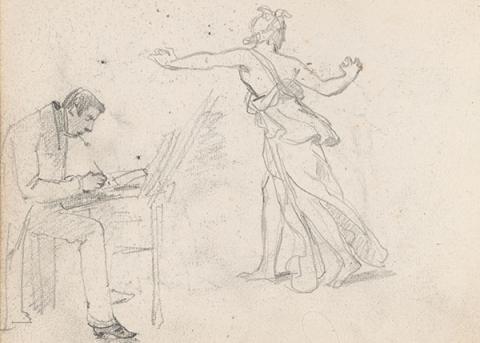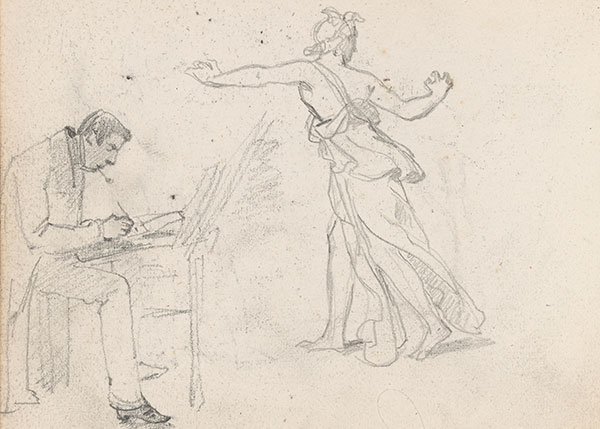

Isidore Pils (1813–1875)
Sketchbook, ca. 1832–1833
Various media, chiefly pencil or black chalk, with some white chalk, and pen and black ink, on wove paper in three colors, chiefly white and gray.
Leaves: 4 1/8 x 5 5/8 inches (105 x 143 mm); Binding: 4 5/16 x 5 15/16 inches (110 x 150 mm).
1989.2
Browse Sketchbook

Isidore Pils (1813–1875)
Sketchbook, 1836
Chiefly pen and black ink, some black and white chalk, on white and brown wove paper
Binding: 4 3/8 x 5 3/4 inches (111 x 147 mm); leaves: 4 3/16 x 5 5/8 inches (107 x 141 mm)
Purchased as the gift of Mrs. Carl Stern
1990.8
Browse Sketchbook
Isidore Pils (1813–1875) was a prolific artist typical of his day: he began as a history painter before embracing realism and found his most distinctive subjects during his travels in 1861–62 to Algeria, then under French rule. The Morgan Library & Museum preserves two early sketchbooks by the artist, one dated 1830–32 and the other dated 1836. A label on the inside front cover of both sketchbooks reveals that Pils acquired them at the shop of Alphonse Giroux, a pupil of Jacques-Louis David and an artist in his own right who opened a store for art supplies, prints, and luxury goods at 7 rue du Coq-Saint-Honore in 1799. The presence of the stamp “Atelier Pils” in both sketchbooks indicates that they remained in his studio until his death. The sale of his estate, including his works and those by artists whom he collected, took place at Drouot, Paris, in 1876. The auction was organized by his friend and biographer L. Becq de Fouquieres, although the artist’s many sketchbooks were not among the sale’s contents, perhaps because they were considered unassuming working documents and thus hard to sell.
The earlier of the two Morgan sketchbooks was used by the artist when he was about seventeen to twenty years old. The first sketches were probably made while he was still a pupil of Guillaume Guillon-Lethiere, with whom he studied beginning in 1830 when he was fifteen years old. With Lethiere’s death in 1832, Pils transferred to the atelier of the Francois Eduard Picot and continued his education for several years before winning the Prix de Rome in 1838 and embarking on the next phase of his development as an artist.
Pils was well-liked but impoverished, and for years struggled to support himself as an artist. He spent a year at Fontainebleau in 1835–36 assisting with the restoration of frescoes before returning to Paris and being admitted to the Hôpital St. Louis. This was the first of several periods of convalescence during his ongoing struggles with tuberculosis. The second of the two sketchbooks is from this period in Paris.
The sketches on these pages chronicle the efforts of an artist absorbing the work of contemporaries and endeavoring to develop his own compositions. These working sketches are interspersed with more personal material, including caricatures (portraits chargée), which reveal the artist’s sense of humor and his affinity for character studies. The quick notations of contemporary scenes, including of artists at work, reveal the perspective of a young man, embracing the public identity of an artist. It is this combination of purposeful drawing–seeking solutions to compositions in progress–and drawing with a less explicit purpose, out of curiosity, for pleasure, to record the life around him, that makes these slight volumes more than the sum of their parts.
These early sketchbooks do not define Pils as an artist but the glimmer of his talent and his perseverance is evident in their pages. They humanize the artist, and the experience of being an artist, in a way that is immediate and relatable. While artists are not often remembered for their juvenilia, Pils’s early sketchbooks serve as a sort of chrysalis from which the more recognizable artist emerges.
